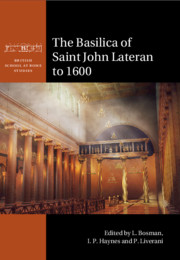Book contents
- The Basilica of Saint John Lateran to 1600
- British School at Rome Studies
- The Basilica of Saint John Lateran to 1600
- Copyright page
- Contents
- Figures
- Contributors
- Acknowledgements
- Abbreviations
- 1 The Lateran Basilica to 1600
- 2 The Evolution of the Lateran: From the Domus to the Episcopal Complex
- 3 At the Foot of the Lateran Hill, from Via Sannio to Viale Ipponio: Archaeological Investigations Prior to the Construction of Metro Line C
- 4 Ground-Penetrating Radar Survey in the Saint John Lateran Basilica Complex
- 5 The First Residential Phases of the Lateran Area and a Hypothesis to Explain the So-Called Trapezoidal Building
- 6 The Castra Nova and the Severan Transformation of Rome
- 7 Andrea Busiri Vici and the Excavations of 1876: A Reassessment of the Archaeological Evidence
- 8 Visualising the Constantinian Basilica
- 9 Constantine’s Spolia: A Set of Columns for San Giovanni in Laterano and the Arch of Constantine in Rome
- 10 The Constantinian Basilica in the Early Medieval Liber Pontificalis
- 11 The Lateran Baptistery in the Fourth and Fifth Centuries: New Certainties and Unresolved Questions
- 12 The Nymphaeum of Pope Hilarus
- 13 Examples of Medieval Construction Techniques in the Basilica of San Giovanni in Laterano
- 14 The Medieval Portico of Saint John Lateran
- 15 MATER ET CAPUT OMNIUM ECCLESIARUM: Visual Strategies in the Rivalry between San Giovanni in Laterano and San Pietro in Vaticano
- 16 The Remodelling of San Giovanni in Laterano by Pope Nicholas IV: Transept, Apse and Façade
- 17 Furtum Sacrilegum: The ‘Holy Heads’ of Peter and Paul and Their Reliquaries in the Lateran
- 18 Reconsidering the Traces of Gentile da Fabriano and Pisanello in the Lateran Basilica
- 19 The Rite of the Reconciliation of Penitents at the Lateran Basilica
- 20 The New Passion Relics at the Lateran, Fifteenth to Sixteenth Centuries: A Translocated Sacred Topography
- 21 The East Façade of the Complex of Saint John Lateran in the Modern Era
- 22 The Book of Acts in the Constantinian Basilica: Cardinal Cesare Baronio and the Navata Clementina in San Giovanni in Laterano
- Bibliography
- Index
6 - The Castra Nova and the Severan Transformation of Rome
Published online by Cambridge University Press: 27 August 2020
- The Basilica of Saint John Lateran to 1600
- British School at Rome Studies
- The Basilica of Saint John Lateran to 1600
- Copyright page
- Contents
- Figures
- Contributors
- Acknowledgements
- Abbreviations
- 1 The Lateran Basilica to 1600
- 2 The Evolution of the Lateran: From the Domus to the Episcopal Complex
- 3 At the Foot of the Lateran Hill, from Via Sannio to Viale Ipponio: Archaeological Investigations Prior to the Construction of Metro Line C
- 4 Ground-Penetrating Radar Survey in the Saint John Lateran Basilica Complex
- 5 The First Residential Phases of the Lateran Area and a Hypothesis to Explain the So-Called Trapezoidal Building
- 6 The Castra Nova and the Severan Transformation of Rome
- 7 Andrea Busiri Vici and the Excavations of 1876: A Reassessment of the Archaeological Evidence
- 8 Visualising the Constantinian Basilica
- 9 Constantine’s Spolia: A Set of Columns for San Giovanni in Laterano and the Arch of Constantine in Rome
- 10 The Constantinian Basilica in the Early Medieval Liber Pontificalis
- 11 The Lateran Baptistery in the Fourth and Fifth Centuries: New Certainties and Unresolved Questions
- 12 The Nymphaeum of Pope Hilarus
- 13 Examples of Medieval Construction Techniques in the Basilica of San Giovanni in Laterano
- 14 The Medieval Portico of Saint John Lateran
- 15 MATER ET CAPUT OMNIUM ECCLESIARUM: Visual Strategies in the Rivalry between San Giovanni in Laterano and San Pietro in Vaticano
- 16 The Remodelling of San Giovanni in Laterano by Pope Nicholas IV: Transept, Apse and Façade
- 17 Furtum Sacrilegum: The ‘Holy Heads’ of Peter and Paul and Their Reliquaries in the Lateran
- 18 Reconsidering the Traces of Gentile da Fabriano and Pisanello in the Lateran Basilica
- 19 The Rite of the Reconciliation of Penitents at the Lateran Basilica
- 20 The New Passion Relics at the Lateran, Fifteenth to Sixteenth Centuries: A Translocated Sacred Topography
- 21 The East Façade of the Complex of Saint John Lateran in the Modern Era
- 22 The Book of Acts in the Constantinian Basilica: Cardinal Cesare Baronio and the Navata Clementina in San Giovanni in Laterano
- Bibliography
- Index
Summary
This chapter examines the impact of the Severan transformation of Rome in Caelian noting its implications for Constatine's later choice of this site for his Lateran Basilica.Septimius Severus dramatically increased the presence of soldiers in Rome and his reign is associated with several major military building projects.The best documented of these is the construction of the Castra Nova for his horse guards (equites singulares), a project that fundamentally reshaped the Caelian. Extensive elements of the fort survive beneath the Basilica of St John Lateran.This chapter explores the evidence for the building and subsequent use of the fort, placing the site in its broader topographical context.Following Constantine's victory at the battle of the Milvian Bridge the equites singulares were destroyed/disbanded and the Castra Nova site was used for the construction of the Lateran Basilica.The paper raises questions about the degree to which the history of the site's use may have impacted on the location and appearence of Constantine's church.
- Type
- Chapter
- Information
- The Basilica of Saint John Lateran to 1600 , pp. 91 - 113Publisher: Cambridge University PressPrint publication year: 2020
- 3
- Cited by

